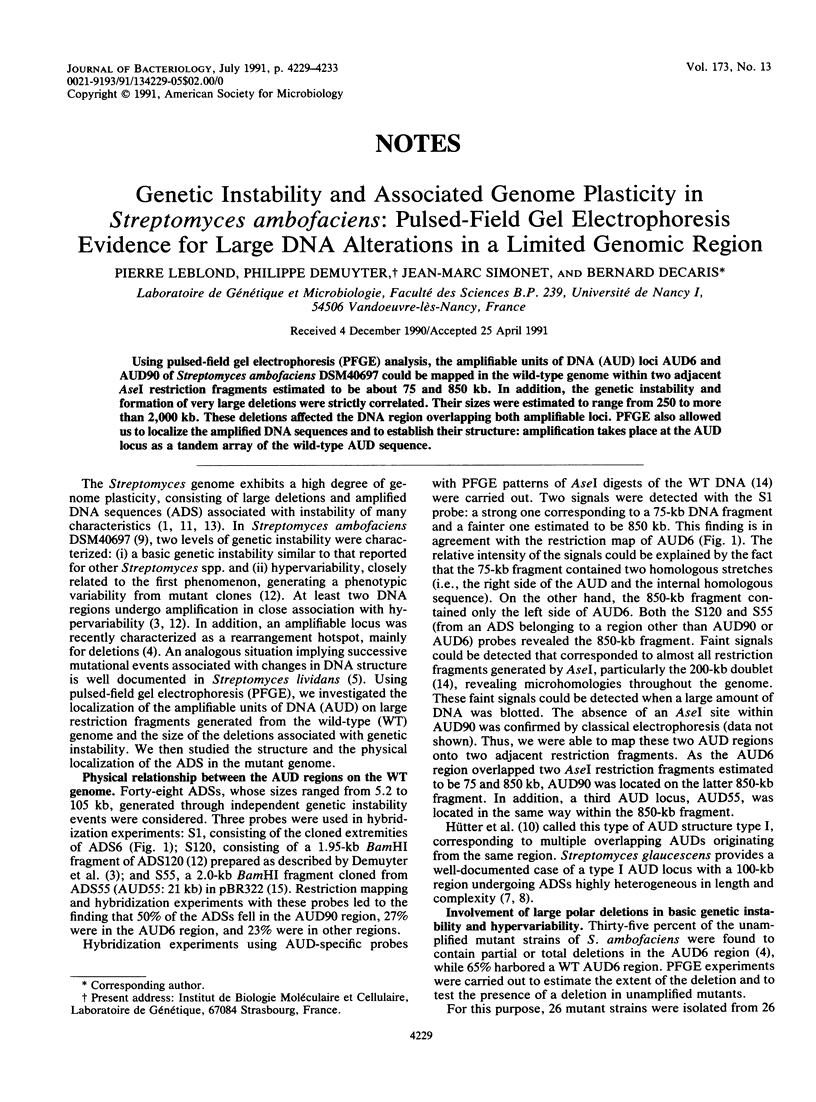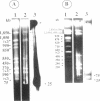Abstract
Using pulsed-field gel electrophoresis (PFGE) analysis, the amplifiable units of DNA (AUD) loci AUD6 and AUD90 of Streptomyces ambofaciens DSM40697 could be mapped in the wild-type genome within two adjacent AseI restriction fragments estimated to be about 75 and 850 kb. In addition, the genetic instability and formation of very large deletions were strictly correlated. Their sizes were estimated to range from 250 to more than 2,000 kb. These deletions affected the DNA region overlapping both amplifiable loci. PFGE also allowed us to localize the amplified DNA sequences and to establish their structure: amplification takes place at the AUD locus as a tandem array of the wild-type AUD sequence.
Full text
PDF




Images in this article
Selected References
These references are in PubMed. This may not be the complete list of references from this article.
- Birch A., Häusler A., Hütter R. Genome rearrangement and genetic instability in Streptomyces spp. J Bacteriol. 1990 Aug;172(8):4138–4142. doi: 10.1128/jb.172.8.4138-4142.1990. [DOI] [PMC free article] [PubMed] [Google Scholar]
- Birch A., Häusler A., Vögtli M., Krek W., Hütter R. Extremely large chromosomal deletions are intimately involved in genetic instability and genomic rearrangements in Streptomyces glaucescens. Mol Gen Genet. 1989 Jun;217(2-3):447–458. doi: 10.1007/BF02464916. [DOI] [PubMed] [Google Scholar]
- Demuyter P., Leblond P., Decaris B., Simonet J. M. Characterization of two families of spontaneously amplifiable units of DNA in Streptomyces ambofaciens. J Gen Microbiol. 1988 Jul;134(7):2001–2007. doi: 10.1099/00221287-134-7-2001. [DOI] [PubMed] [Google Scholar]
- Dyson P., Schrempf H. Genetic instability and DNA amplification in Streptomyces lividans 66. J Bacteriol. 1987 Oct;169(10):4796–4803. doi: 10.1128/jb.169.10.4796-4803.1987. [DOI] [PMC free article] [PubMed] [Google Scholar]
- Flett F., Cullum J. DNA deletions in spontaneous chloramphenicol-sensitive mutants of Streptomyces coelicolor A 3(2) and Streptomyces lividans 66. Mol Gen Genet. 1987 May;207(2-3):499–502. doi: 10.1007/BF00331621. [DOI] [PubMed] [Google Scholar]
- Hasegawa M., Hintermann G., Simonet J. M., Crameri R., Piret J., Hütter R. Certain chromosomal regions in Streptomyces glaucescens tend to carry amplifications and deletions. Mol Gen Genet. 1985;200(3):375–384. doi: 10.1007/BF00425720. [DOI] [PubMed] [Google Scholar]
- Häusler A., Birch A., Krek W., Piret J., Hütter R. Heterogeneous genomic amplification in Streptomyces glaucescens: structure, location and junction sequence analysis. Mol Gen Genet. 1989 Jun;217(2-3):437–446. doi: 10.1007/BF02464915. [DOI] [PubMed] [Google Scholar]
- Leblond P., Demuyter P., Moutier L., Laakel M., Decaris B., Simonet J. M. Hypervariability, a new phenomenon of genetic instability, related to DNA amplification in Streptomyces ambofaciens. J Bacteriol. 1989 Jan;171(1):419–423. doi: 10.1128/jb.171.1.419-423.1989. [DOI] [PMC free article] [PubMed] [Google Scholar]
- Leblond P., Demuyter P., Simonet J. M., Decaris B. Genetic instability and hypervariability in Streptomyces ambofaciens: towards an understanding of a mechanism of genome plasticity. Mol Microbiol. 1990 May;4(5):707–714. doi: 10.1111/j.1365-2958.1990.tb00641.x. [DOI] [PubMed] [Google Scholar]
- Leblond P., Francou F. X., Simonet J. M., Decaris B. Pulsed-field gel electrophoresis analysis of the genome of Streptomyces ambofaciens strains. FEMS Microbiol Lett. 1990 Oct;60(1-2):79–88. doi: 10.1016/0378-1097(90)90349-u. [DOI] [PubMed] [Google Scholar]






